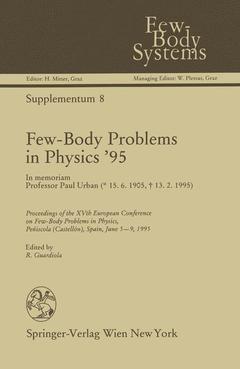Few-Body Problems in Physics ’95, Softcover reprint of the original 1st ed. 1996 In memoriam Professor Paul Urban Few-Body Systems Series, Vol. 8
Langue : Anglais
Coordonnateur : Guardiola Rafael

Proceedings of the XVth European Conference on Few-Body Problems in Physics, Peniscola (Castellon), Spain, June, 5 - 9, 1995
Session 1: Methods in the Few-Body Problem.- Paul Urban: Promoter of Modern Theoretical Physics.- Nuclear Three- and Four-Body Systems.- Correlated Hyperspherical Harmonic Functions for Few-Nucleon Systems.- Session 2: Methods in the Few-Body Problem.- Recent Progress in Path Integral Calculations of Nuclei.- Convergence Properties of the Adiabatic Expansion for Few-Nucleon Systems.- Cross Sections and Vector Analyzing Powers in the Proton Induced Deuteron Breakup Reaction at 65 MeV: Star Configurations.- Single Particle Spectral Function for Finite Nuclei.- Session 3: Atomic and Molecular Systems.- Few-Body Problems in Atomic Physics.- Molecular Potentials and Relativistic Effects.- Strong Correlation in Three-Particle Continuum A++ + e + e: Theory and Visualization.- Faddeev Approach to Scattering in Atomic and Mesic Atomic Systems.- Session 4: Methods in the Few-Body Problem.- Precise Nonvariational Calculation of Resonant States of Helium with the Correlation Function Hyperspherical Harmonic Method.- A Coupled-Channel Formalism for Breakup Reactions.- $${}^{2}\text{H(}\vec{d},p{{\text{)}}^{3}}\text{H}$$3H Reaction Calculations at 20–120 keV by the Four-Body Yakubovsky Equations with the Paris Potential.- Integral Equation Calculations for the Photodisintegration of 4He.- Session 5: Strong and Electromagnetic Interactions.- Spin Observables in High Energy Electron Scattering.- Pion Nucleus Scattering.- Recent Developments in one and two Pion Production in Elementary Reactions and Few-Body Systems.- Session 6: Strong and Electromagnetic Interactions.- Plans for Nucleon-Nucleon Bremsstrahlung Measurements with AGOR.- First Results on Proton-Proton Scattering and Near Threshold Two Meson Production at COSY.- Study of Proton-Neutron Correlations with the reaction3,4He(e, e?d).- Selected Topics of the Few-Nucleon Research Program at TUNL.- Measurement of the Spin-dependent Structure Function g1(x) of the Deuteron and the Proton.- Session 7: Strong and Electromagnetic Interactions.- Double Pion Photoproduction on the Proton up to 800 MeV.- High Missing-Momentum Components in 4He Studied with the (e, e?p) Reaction.- Electron-Deuteron Scattering with the New Generation of Nucleon-Nucleon Potentials.- Polarization Studies of Few Nucleon Systems at Laboratory for High Energies of Joint Institute for Nuclear Research.- Panel Session 8: Few-Body Systems Probed in Several Ways.- Achievements and Perspectives in the Field of Few-Body Systems Studied with Hadronic Probes.- Few-Body Systems Probed in Several Ways.- Session 9: Atomic Clusters and Exotic Atoms.- Theoretical Description of Helium Clusters.- Antiprotonic Helium Atoms.- Muon Catalyzed Fusion.- Precision Measurement of Nuclear Muon Capture by 3He.- Session 10: Nuclear Forces, Chirality and Relativistic Effects.- The ?NN Coupling from High Precision np Charge Exchange Data.- Two-Body Components in the Nucleon Wave Function and their Consequences in Various Phenomena.- Hidden Local Symmetries and Meson Exchange Currents.- Relativistic Calculations of the Deuteron Form Factors and Triton Binding Energy.- Session 11: Antiprotonic and Strange Systems.- Glueballs, ? and ?? Mesons and Antiproton-Proton Annihilation Dynamics.- ? Production via the Strong Interaction.- ?-Physics with Electromagnetic Probes.- Interaction of ?-Meson with Light Nuclei.- Session 12: Few-Body Problems in Astrophysics.- Nuclear Reactions of Astrophysical Interest Involving Light Nuclei.- Optical Theorem and Finite-Range Effect for Nuclear Reactions in Astrophysics.- Peripheral AstrophysicalRadiative Capture Processes.- Session 13a: Quark Structure of Hadrons.- Towards a Unified Description of the Baryon Spectrum and the Baryon-Baryon Interaction within a Potential Model Scheme.- Nucleon and Pion Electromagnetic Structure and Constituent Quark Form Factors.- On the Dynamical Retardation Effect for the Mass Spectrum of Heavy Quarkonia.- Relativistic Quark Model Baryon Analysis.- Polarized Structure Functions and the Nucleon Spin.- Quark-Gluon Point of View on the Spin Structure of the Deuteron from Experiments with Relativistic Deuteron Beams.- Session 13b: Nuclear Structure and Reactions.- Searching for 6Li D-state Effects.- Comparison between Three-Body and Many-Body Descriptions of 11Li.- Light Ion Induced Reactions at Intermediate Energies.- An Analysis of the Use of the Cluster Separability in Scattering Theory.- Method of Integral Transforms for Calculating (e, e?) and (e, e?N) Reactions.- Effect of the Three-Nucleon Force Based on ?-Isobar Excitation in Neutron-Deuteron Scattering.- Session 14a: Physics with Strange Particles and Antiprotons.- Electromagnetic Associated Strangeness Production and Hadron Form Factors.- ?-Helium Scattering.- $$\bar{p}N$$ Scattering with Annihilation Channel in an Extended Hilbert Space Model.- ?I = 1/2 Rule: Interplay of Quark and Hadronic Degrees of Freedom.- Session 14b: Relativistic Effects and Antiprotonic Atoms.- Asymptotic Behavior of the Deuteron Extra-Components in the Covariant Light Front Dynamics.- Nucleon-Nucleon Correlations and Inclusive Electron Scattering off Few-Nucleon Systems at x > 1.- Antiproton Helium Polarization States.- Antiproton Delayed Annihilation: the Problem of the Description in Isolated Atom Model and Other Possible Scenarios.- Session 15: The Baryon-Baryon Interaction.- TheNijmegen Potentials.- The Bonn Potential.- The Nature of the Baryon-Baryon Interaction in the Quark-Model.- Nuclear Forces and Chiral Theories.- Panel Session 16: Relativistic Effects in the Few-Body Problem.- Field Theory Approach in Few-Body Systems.- Application of the Few-Body Theory to Deep Inelastic Lepton-Nucleon Scattering.- Session 17: Closing session.- From the Structure of Nucleons to that of Complex Nuclei: the Role Played by Few-Body Physics.- List of Participants.- List of Authors.
Date de parution : 11-2013
Ouvrage de 540 p.
17x24.4 cm
Thème de Few-Body Problems in Physics ’95 :
Mots-clés :
Baryon; Cross section; Lepton; Meson; Neutron; Quark; Session; Strangeness; chirality; cluster; hadron; measurement; particles; scattering; spectra
© 2024 LAVOISIER S.A.S.


